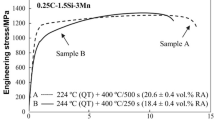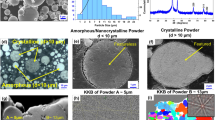Abstract
Reducing energy consumption and exploring the potential of materials in depth is a long-term pursuit of goals and development directions in the field of extrusion technology. If load reduction and material performance can be achieved at the same time, this is a good strategy to solve the bottleneck. For the first time, a pre-upsetting technique was used before alternating extrusion in this investigation, which enhances grain refinement and increases the Schmid factor. This reduced the single grain yield strength and the load of the second process. The results of comparative research show that compared with interactive alternating forward extrusion (AFE), pre-upsetting alternate forward extrusion (UAFE) can significantly reduce the peak load required for forming, which increases the tensile strength of extruded AZ31 magnesium alloy products by 41.9% and the ductility to 23.7%. The average grain size was only 1/2 of the conventional alternating extrusion grain size, and the strength of the texture was weakened to 8.62. The increase in tensile strength is mainly due to fine-grained strengthening. Grain boundaries can hinder dislocation movement. Some grains are inclined from the original typical fiber texture to the ED direction during pre-upsetting, which effectively reduces the texture strength of UAFE and increases the ductility of the material. This provides scientific guidance and technical support for the development and application of high-performance magnesium alloy extrusion forming technology.









Similar content being viewed by others
Availability of data and materials
The data obtained in the framework of this study are available to the journal upon request.
References
Zeng ZR, Stanford N, Davies CHJ, Nie JF, Birbilis N (2019) Magnesium extrusion alloys: a review of developments and prospects. Int Mater Rev 64(1):27–62. https://doi.org/10.1080/09506608.2017.1421439
Song JF, She J, Chen DL, Pan FS (2020) Latest research advances on magnesium and magnesium alloys worldwide. J Magnes Alloy 8(1):1–41. https://doi.org/10.1016/j.jma.2020.02.003
Che B, Lu LW, Zhang JL, Zhang JH, Ma M, Wang LF, Qi FG (2022) Effects of cryogenic treatment on microstructure and mechanical properties of AZ31 magnesium alloy rolled at different paths. Mater Sci Eng A 832. https://doi.org/10.1016/j.msea.2021.142475
Zhang Z, Zhang JH, Xie JS, Liu SJ, He YY, Guan K, Wu RZ (2022) Developing a low-alloyed fine-grained Mg alloy with high strength-ductility based on dislocation evolution and grain boundary segregation. Scr Mater 209. https://doi.org/10.1016/j.scriptamat.2021.114414
Yan ZM, Li XB, Zheng J, Zhang ZM, Wang Q, Xu KH, Fan HZ, Zhang GS, Zhu JX, Xue Y (2021) Microstructure evolution, texture and mechanical properties of a Mg–Gd–Y–Zn–Zr alloy fabricated by cyclic expansion extrusion with an asymmetrical extrusion cavity: the influence of passes and processing route. J Magnes Alloy 9(3):964–982. https://doi.org/10.1016/j.jma.2020.06.016
Alaneme KK, Okotete EA (2017) Enhancing plastic deformability of Mg and its alloys-a review of traditional and nascent developments. J Magnes Alloy 5(4):460–475. https://doi.org/10.1016/j.jma.2017.11.001
Agnew SR, Nie JF (2010) Preface to the viewpoint set on: the current state of magnesium alloy science and technology. Scr Mater 63(7):671–673. https://doi.org/10.1016/j.scriptamat.2010.06.029
Pan FS, Wang QH, Jiang B, He JJ, Chai YF, Xu J (2016) An effective approach called the composite extrusion to improve the mechanical properties of AZ31 magnesium alloy sheets. Mater Sci Eng A 655:339–345. https://doi.org/10.1016/j.msea.2015.12.098
Lu LW, Liu CM, Zhao J, Zeng WB, Wang ZC (2015) Modification of grain refinement and texture in AZ31 Mg alloy by a new plastic deformation method. J Alloys Compd 628:130–134. https://doi.org/10.1016/j.jallcom.2014.12.196
Xu J, Song JF, Jiang B, He JJ, Wang QH, Liu B, Huang GS, Pan FS (2017) Effect of effective strain gradient on texture and mechanical properties of Mg-3Al-1Zn alloy sheets produced by asymmetric extrusion. Mater Sci Eng A 706:172–180. https://doi.org/10.1016/j.msea.2017.09.004
Li F, Zeng X, Chen Q, Cao GJ (2015) Effect of local strains on the texture and mechanical properties of AZ31 magnesium alloy produced by continuous variable cross-section direct extrusion (CVCDE). Mater Des 85:389–395. https://doi.org/10.1016/j.matdes.2015.06.168
Zhang WN, Zhang H, Wang LF, Fan JF, Li X, Zhu LL, Chen SY, Roven HJ, Zhang SZ (2020) Microstructure evolution and mechanical properties of AZ31 magnesium alloy sheets prepared by low-speed extrusion with different temperature. Crystals 10(8). https://doi.org/10.3390/cryst10080644
Wang Y, Li F, Wang Y, Gao L (2020) Effect of dynamic recrystallization on grain refinement during interactive alternating forward extrusion of AZ31B magnesium alloy. J Mater Eng Perform 29(5):2748–2756. https://doi.org/10.1007/s11665-020-04780-3
Wang Y, Li F, Wang Y, Xiao XM (2021) Texture property and weakening mechanism of Mg-3Al-1Zn alloy by interactive alternating forward extrusion. J Magnes Alloy. https://doi.org/10.1016/j.jma.2021.05.007
Li F, Jiang HW, Chen Q, Liu Y (2017) New extrusion method for reducing load and refining grains for magnesium alloy. Int J Adv Manuf Technol 90(1–4):73–79. https://doi.org/10.1007/s00170-016-9323-8
Li F, Jiang HW, Liu Y (2017) Microstructure and texture evolution during the alternate extrusion of an AZ31 magnesium alloy. JOM 69(1):93–99. https://doi.org/10.1007/s11837-016-2146-0
Al-Samman T, Gottstein G (2008) Room temperature formability of a magnesium AZ31 alloy: examining the role of texture on the deformation mechanisms. Mater Sci Eng A 488(1–2):406–414. https://doi.org/10.1016/j.msea.2007.11.056
Molodov KD, Al-Samman T, Molodov DA, Gottstein G (2014) Mechanisms of exceptional ductility of magnesium single crystal during deformation at room temperature: multiple twinning and dynamic recrystallization. Acta Mater 76:314–330. https://doi.org/10.1016/j.actamat.2014.04.066
Song B, Xin RL, Chen G, Zhang XY, Liu Q (2012) Improving tensile and compressive properties of magnesium alloy plates by pre-cold rolling. Scr Mater 66(12):1061–1064. https://doi.org/10.1016/j.scriptamat.2012.02.047
Zhang GS, Meng YZ, Yan FF, Gao Z, Yan ZM, Zhang ZM (2020) Microstructure and texture evolution of Mg-RE-Zn alloy prepared by repetitive upsetting-extrusion under different decreasing temperature degrees. J Alloys Compd 815. https://doi.org/10.1016/j.jallcom.2019.152452
Wang Y, Li F, Wang Y, Chen Q, Li XW, Fang WB (2022) Role of grain refinement mechanism on microstructure and performance in AZ31B alloy during interactive alternating forward extrusion (AFE) process. Met Mater Int 28(4):823–832. https://doi.org/10.1007/s12540-020-00962-9
Vaishakh KV, Narasimhan R, Yazar KU, Suwas S (2020) Mixed-mode (I and II) fracture behavior of a basal-textured magnesium alloy. Acta Mater 193:99–114. https://doi.org/10.1016/j.actamat.2020.03.023
Orlov D, Raab G, Lamark TT, Popov M, Estrin Y (2011) Improvement of mechanical properties of magnesium alloy ZK60 by integrated extrusion and equal channel angular pressing. Acta Mater 59(1):375–385. https://doi.org/10.1016/j.actamat.2010.09.043
Yan ZM, Zhang ZM, Li XB, Xu J, Wang Q, Zhang GS, Zheng J, Fan HZ, Xu KH, Zhu JX, Xue Y (2020) A novel severe plastic deformation method and its effect on microstructure, texture and mechanical properties of Mg-Gd-Y-Zn-Zr alloy. J Alloys Compd 822. https://doi.org/10.1016/j.jallcom.2020.153698
Yuan W, Panigrahi SK, Su JQ, Mishra RS (2011) Influence of grain size and texture on Hall-Petch relationship for a magnesium alloy. Scr Mater 65(11):994–997. https://doi.org/10.1016/j.scriptamat.2011.08.028
Li CL, Mei QS, Li JY, Chen F, Ma Y, Mei XM (2018) Hall-Petch relations and strengthening of Al-ZnO composites in view of grain size relative to interparticle spacing. Scr Mater 153:27–30. https://doi.org/10.1016/j.scriptamat.2018.04.042
Hansen N (2004) Hall-Petch relation and boundary strengthening. Scr Mater 51(8):801–806. https://doi.org/10.1016/j.scriptamat.2004.06.002
Wang C, Ning H, Liu S, You J, Wang T, Jia HJ, Zha M, Wang HY (2021) Enhanced ductility and strength of Mg-1Zn-1Sn-0.3Y-0.2Ca alloy achieved by novel micro-texture design. Scr Mater 204. https://doi.org/10.1016/j.scriptamat.2021.114119
Xu J, Yang TH, Jiang B, Song JF, He JJ, Wang Q, Chai YF, Huang GS, Pan FS (2018) Improved mechanical properties of Mg-3Al-1Zn alloy sheets by optimizing the extrusion die angles: microstructural and texture evolution. J Alloys Compd 762:719–729. https://doi.org/10.1016/j.jallcom.2018.05.083
Srinivasarao B, Dudamell NV, Perez-Prado MT (2013) Texture analysis of the effect of non-basal slip systems on the dynamic recrystallization of the Mg alloy AZ31. Mater Charact 75:101–107. https://doi.org/10.1016/j.matchar.2012.10.002
Koike J, Ohyama R (2005) Geometrical c-Titerion for the activation of prismatic slip in AZ61 Mg alloy sheets deformed at room temperature. Acta Mater 53(7):1963–1972. https://doi.org/10.1016/j.actamat.2005.01.008
Nan XL, Wang HY, Zhang L, Li JB, Jiang QC (2012) Calculation of Schmid factors in magnesium: analysis of deformation behaviors. Scr Mater 67(5):443–446. https://doi.org/10.1016/j.scriptamat.2012.05.042
Qin DH, Wang MJ, Sun CY, Su ZX, Qian LY, Sun ZH (2020) Interaction between texture evolution and dynamic recrystallization of extruded AZ80 magnesium alloy during hot deformation. Mater Sci Eng A 788. https://doi.org/10.1016/j.msea.2020.139537
Gui YW, Ouyang LX, Cui YJ, Bian HK, Li QA, Chiba A (2021) Grain refinement and weak-textured structures based on the dynamic recrystallization of Mg-9.80Gd-3.78Y-1.12Sm-0.48Zr alloy. J Magnes Alloy 9(2):456–466. https://doi.org/10.1016/j.jma.2020.06.001
Cepeda-Jimenez CM, Molina-Aldareguia JM, Perez-Prado MT (2015) Origin of the twinning to slip transition with grain size refinement, with decreasing strain rate and with increasing temperature in magnesium. Acta Mater 88:232–244. https://doi.org/10.1016/j.actamat.2015.01.032
Jiang MG, Xu C, Yan H, Fan GH, Nakata T, Lao CS, Chen RS, Kamado S, Han EH, Lu BH (2018) Unveiling the formation of basal texture variations based on twinning and dynamic recrystallization in AZ31 magnesium alloy during extrusion. Acta Mater 157:53–71. https://doi.org/10.1016/j.actamat.2018.07.014
Tong LB, Chu JH, Sun WT, Jiang ZH, Zou DN, Liu SF, Kamado S, Zheng MY (2021) Development of a high-strength Mg alloy with superior ductility through a unique texture modification from equal channel angular pressing. J Magnes Alloy 9(3):1007–1018. https://doi.org/10.1016/j.jma.2020.03.011
Wang Y, Chen G, Chen Z, Wan H, Xiao H, Chang X (2022) Electropulsing assisted aging with ultrafast hardening rate for AerMet100 steel. Mater Sci Eng A 841:143066. https://doi.org/10.1016/j.msea.2022.143066
Gehrmann R, Frommert MM, Gottstein G (2005) Texture effects on plastic deformation of magnesium. Mater Sci Eng A 395(1–2):338–349. https://doi.org/10.1016/j.msea.2005.01.002
Wu XL, Zhu YT (2017) Heterogeneous materials: a new class of materials with unprecedented mechanical properties. Mater Res Lett 5(8):527–532. https://doi.org/10.1080/21663831.2017.1343208
Sandlobes S, Friak M, Zaefferer S, Dick A, Yi S, Letzig D, Pei Z, Zhu LF, Neugebauer J, Raabe D (2012) The relation between ductility and stacking fault energies in Mg and Mg-Y alloys. Acta Mater 60(6–7):3011–3021. https://doi.org/10.1016/j.actamat.2012.02.006
Hou DW, Liu TM, Chen HC, Shi DF, Ran CH, Pan FS (2016) Analysis of the microstructure and deformation mechanisms by compression along normal direction in a rolled AZ31 magnesium alloy. Mater Sci Eng A 660:102–107. https://doi.org/10.1016/j.msea.2016.02.020
Foley DC, Al-Maharbi M, Hartwig KT, Karaman I, Kecskes LJ, Mathaudhu SN (2011) Grain refinement vs. crystallographic texture: mechanical anisotropy in a magnesium alloy. Scr Mater 64(2):193–196. https://doi.org/10.1016/j.scriptamat.2010.09.042
Liu W, Ma YB, Zhang YG, Fan XX, Xu CX, Zhang JS (2017) Two dynamic recrystallization processes in a high-performance extruded Mg94.5Y2Gd1Zn2Mn0.5 alloy. Mater Sci Eng A 690:132–136. https://doi.org/10.1016/j.msea.2017.02.088
Acknowledgements
This project is supported by the National Natural Science Foundation of China (No. 51975166).
Author information
Authors and Affiliations
Contributions
New extrusion technology is currently a hot research direction in the field of plastic processing. A predeformation alternating extrusion process was proposed in this paper, which can provide a new idea for the preparation of high-performance magnesium alloy.
Corresponding authors
Ethics declarations
Ethics approval
Not applicable.
Consent to participate
Not applicable.
Consent for publication
Not applicable.
Competing interests
The authors declare no competing interests.
Additional information
Publisher's Note
Springer Nature remains neutral with regard to jurisdictional claims in published maps and institutional affiliations.
Rights and permissions
About this article
Cite this article
Du, H.Q., Li, F., Wang, Y. et al. Modification of grain refinement and texture based on pre-upsetting AZ31 Mg alloy in interactive alternating forward extrusion. Int J Adv Manuf Technol 121, 4805–4815 (2022). https://doi.org/10.1007/s00170-022-09684-1
Received:
Accepted:
Published:
Issue Date:
DOI: https://doi.org/10.1007/s00170-022-09684-1




